“I chose to quite cram school to see Yamato 2”
Interview with Yamato 2202 Scriptwriter Hideki Oka
Published by Gigazine on October 20, 2017. See the original article here
Yamato 2202 Chapter 3, Pure Love Chapter, comes to theaters October 14, 2017. For this work, Hideki Oka is responsible for writing the scripts with Harutoshi Fukui. Mr. Oka, who overflows with Yamato love, participates at the recommendation of Director Nobuyoshi Habara, who also has a strong passion for Yamato himself. Mr. Oka speaks passionately about his Yamato love, including a moment when he quit cram school to see Yamato 2 in his junior high days. (Mr. Habara was also present.)
Interviewer: Of the staff making Yamato 2202, you fall between Director Habara and Series Writer Mr. Fukui in terms of age. What works touched you prior to Yamato?
Oka: At the time it was called “TV manga” and included both live-action and anime. I saw just about everything that was shown on TV back when I was elementary school age.
Interviewer: Everything!
Oka: Well, maybe that’s overstating it. I should explain; in my house there was a strict “one hour of TV a day” rule, and since I had to make desperate choices I watched every program.
Interviewer: Wow…you managed that in one hour.
Oka: I could see half of four shows per day (Laughs) or around 5-6 episodes. I got the gist of the show and the feeling was “Okay, I got it in general.” I was just a kid. Since the number of channels in Hiroshima was small, there were a lot of cases where all the show were on in the same timeslot.
Habara: Oh, I see.
Oka: I was told not to watch Tensai Bakabon.
Habara: Eh!? Why not?
Oka: My parents said, “You’ll become stupid if you watch that.” But the charm of Lupin III was good.
Interviewer: That one was safe? (Laughs)

Oka: I watched Bakabon anyway (Laughs), so there were few programs that I didn’t know. But didn’t it seem like TV kids of that era grew up during an easygoing time?
Habara: Certainly, it seems like that.
Oka: Since I was a certain kind of kid, pictures of monsters and Ultraman and TV manga were drawn in my notebook.
Habara: Like Tiger Mask.
Oka: Yeah, Tiger Mask! And when Kamen Rider started, the number of Kamen Rider sketches increased quickly. Mazinger Z, too. “Wow, what a face!” “What kind of shape is that? I don’t get it.” I kept drawing away despite this torture. When it got to Great Mazinger, my brain development finally caught up to the point where I was able to capture complex 3D objects. Then Yamato appeared in the fall [of 1974].
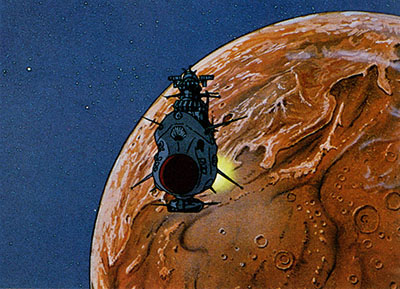
Interviewer: You came to it.
Oka: And, “I don’t get it!” (All laugh) “What’s going on in this?” Was it too complicated? There were so many lines I couldn’t get it through my head. It was an image like a “stegosaurus flying in space.” Because of the sharp objects concentrated at the top of the ship, it looked to me like a stegosaurus. In Episode 3, Yamato went into space. (All laugh)
Habara: I see. (Laughs)
Oka: It became an alien object like a stegosaurus with a weird black hole in its face. My first impression was, “What is this? What’s happening here?”
Interviewer: That’s what kind of encounter it was? At that time, regardless of target age, Yamato appeared when “TV manga” was picking up, and everyone said, “A great thing has begun!”
Oka: However, since I was in a different grade from Mr. Habara, almost none of my friends talked about Yamato.
Habara: Hmm, that’s right.
Oka: I hesitated about it in those days and went over to Monkey Army instead. (A live-action tokusatsu show in the same time slot.) So I had to pick up Yamato in a later broadcast. However, my parents loved Yamato, and it’s striking for a child to wonder, “What kind of thing impresses my parents?” When Yamato was rerun, I got absorbed. Many people across the nation were hooked by the reruns, and I was one of those.
Habara: I remember that.
Interviewer: As you grew up, was it shameful not to graduate from anime?
Oka: A little bit. I think it was about at the end of fourth grade. However, I “re-enlisted” soon after that. (Laughs) The revival boom started around the time of fifth grade. At that time, Yamato fan activities were spreading across the country, and the movement to re-evaluate Ultraman was also emerging. When I was in the first year of junior high, my surroundings were completely full of that kind of thing.
Habara: Oh, yeah.
Oka: When Star Wars and Farewell to Yamato came out in the summer of 1978, it became an unforgettable summer that determined my fate. What I saw, what I felt, what it was like to live through that, they’ll stay with me for the rest of time. It was the driving force behind becoming an assistant director of movies and TV dramas, and it was the root of being invited here by Mr. Habara.
Habara: That’s right.
Interviewer: I’m envious that you were able to experience such a summer.
Oka: The summer of 1978 is a “sacred place” for me. Personally, I have the impression that everything was decided for me that summer.
Habara: At that age, I guess it was good timing.
Oka: When I became a junior high student, everything expanded. That’s when I saw the sequel to Space Battleship Yamato. The next year it was Galaxy Express 999. I was immersed in the illusion that, “There is a wonderful world different from here in some far-off place, and I’m sure I will travel there.” It was quite reckless when I think back on it now, but I think a lot of kids thought that in those days.
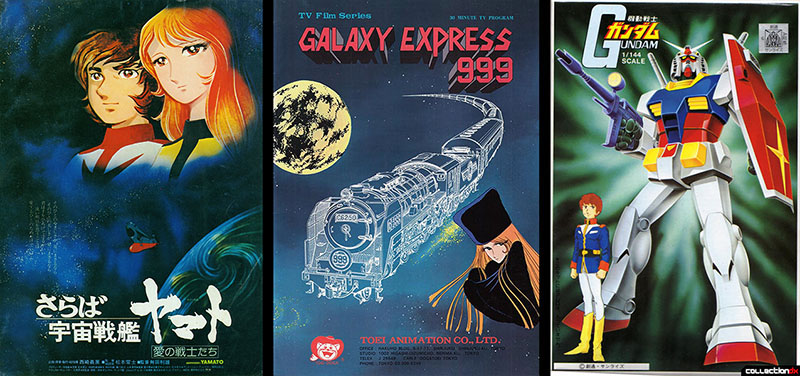
Interviewer: Did everyone get excited in your junior high?
Oka: Yes. The boys and girls certainly were talking about Yamato, weren’t they? Just after Gundam came out, there was the impression that the class stance against fiction had changed somewhere. Before Gundam, I think anime was grouped under the word “roman” [romantic], but with Gundam there was “cynical,” and “aligning with reality,” so everyone learned that “Anime can have this in it, too.”
As a result, I feel that I came to see anime a little more objectively and critically. It may be that its growth and trends happened just like that, and I’m of that generation. However, as the surroundings changed and the works also changed, Yamato took on an old-fashioned scent and it kept being pushed aside.
Interviewer: Step by step.
Oka: But Yamato is exceptional, and I wanted to continue getting the taste of Yamato and kept chasing that “Yamato scent” in other works, trying to see it wherever I thought I could.
Interviewer: Where there any works outside the Yamato series that had that Yamato scent?
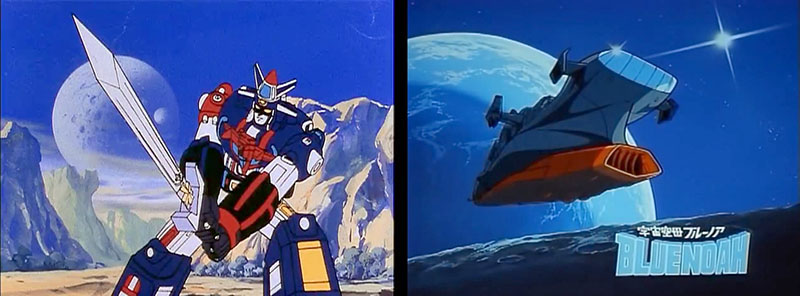
Oka: Armored Armada Dairugger 15. “Why does this look so much like Yamato?” There were places where it was a bit rough, but it was somewhat similar.
Habara: I understand!
Oka: There was also a place near the end of Space Carrier Blue Noah where the staff changed a little and Keisuke Fujikawa was the main scriptwriter. I remember thinking, “I can taste more Yamato in this!” and I began to watch it with delight.
Habara: Because it had the same staff. (Laughs)
Interviewer: Yamato became a big social phenomenon with Farewell and after that it returned as Yamato 2. Mr. Habara had already decided to become an animator, and I heard a story that he was glad to see Yoshinori Kanada worked on it as an animator. What about you, Mr. Oka?
Oka: Farewell made a huge impression on me, and I was in tears at the end. But then it began again two months later [as Yamato 2]. I thought, “But surely it will live forever in your heart and soul…” and “Since it’s starting over I have to see everything.” So I watched it. In fact, I quite cram school…
Habara: Really! To watch it?
Oka: On the day the first episode was broadcast, I skipped cram school. Already, an irreparable mistake! I dropped out from the second episode on and chose a Yamato frame of mind.
Interviewer: What! (Laughs)

Oka: I was reckless in the fall of seventh grade, wasn’t I?
Habara: At the time when English gradually gets harder. (Laughs)
Oka: How did I persuade my parents…? I can’t remember, but I quit.
Interviewer: It’s amazing that you would quit to see it. (Laughs)
Habara: I’m hearing it for the first time, too.
Oka: But you failed to see the first episode.
Habara: I was annoyed by that.
Oka: It’s unimaginable to kids today that it seemed like a once-in-a-lifetime chance. (Laughs)
Habara: Back then you couldn’t even get it on video, but now you can see it on the net. (Laughs)
Oka: It was a time when an ordinary home had no video.
Interviewer: You mentioned before that the summer of 1978 was like a milestone. Is that the time you decided to get on the path of making visuals?
Oka: I went to see Star Wars in July of that year. I went in the morning, and on the way home all I could think was “I’ll become a movie director!” (Laughs) I had nothing else to do, so I stayed from morning till night and saw it four times. It had such an impact that between the time I left and the time I came back, I was a different person. I’d seen movies before, but it was after Star Wars that I started to think, “I want to go over to the moviemaker side.”
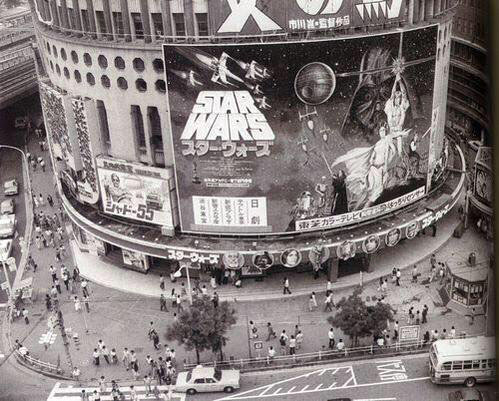
Tokyo movie theater, summer 1978
Habara: Was there movie-related work in your house?
Oka: No, my father was a bank clerk and my mother worked in a women’s clothing store, so it was a normal home. But then I happened to see Star Wars. When I think back on it now, I feel like that’s when I began to look at a variety of things with a critical eye. Yamato 2 was the first anime I saw with that consciousness.
Habara: “I’d like to do this.” (Laughs)
Oka: That’s right. At the time, my feeling was, “I’d like to do this.”
Interviewer: It might have been a great thing that you saw Yamato 2 with the eyes of a moviemaker after that.
Oka: It comes back to me when I talk about that time. It was sort of magical…I had a feeling inside that “It’s natural for Yamato to exist.” Why would I think that?
Habara: Because you encountered one after the other?
Oka: When I look back at it now, they came one after the other, but it was five months or a year between works, which is quite a long time for a child, isn’t it? But I had no sense of them passing by for some reason. Maybe the world is better because I thought, “I won’t let go of Yamato.” That kind of passion runs throughout the world, including in business, so I sort of felt Yamato was “Something that can be seen any time.” I was caught up in the feeling that, “It’s naturally a good thing that shows us something interesting each time.” But it was different with Final Yamato because it was clear that the world no longer needed Yamato. All I thought when I went to see it was, “If I don’t go, who will?”
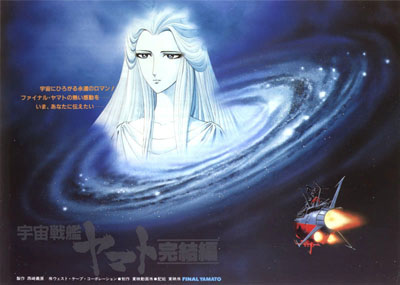
Habara: It was out at the same time as Crusher Joe.
Interviewer: It’s very convincing that Mr. Habara would recommend you, Mr. Oka.
Habara: Right? I’ve watched Tiger Mask while picking a pot with Mr. Oka, and because I had the sense that, “He feels very much like I do while watching this,” I thought, “We’re exactly the same.”
Oka: Right. I was working in Indonesia and hadn’t been in Japan for a year and a half, and an email suddenly came from Mr. Habara when I was on the verge of returning home. It said, “It has been decided that Xebec will make a sequel to 2199, please write a proposal.” (Laughs)
Habara: For Farewell and Yamato 2…
Oka: “A remake of the White Comet story.” At first I thought, “Are you kidding me? What’s happening?” But what I heard was true, so I said, “Let me think freely about it a little” and that’s the reason I sent a proposal to Mr. Habara.
Interviewer: Did the 2199 theatrical screenings happen while you were outside Japan?
Oka: I could only see 2199 Chapter 7 when I returned home temporarily, so I ran out to a Tsutaya [store]. I was in Indonesia when Ark of the Stars opened in theaters, so I got the Blu-ray later. I loved Ark, and when Mr. Habara asked me for the proposal, I thought, “We’ve encountered Gatlantis in this continuity, so I’m going to start with the state of Garmillas, Gatlantis, and Earth in a three-way deadlock…” I wrote freely to come up with an improvised story with three themes and threw it at Mr. Habara.
Interviewer: To write the scripts for this work, Harutoshi Fukui created the overall flow that was separated into episodes and Mr. Oka does the script. It seems that everyone chatters about it while reading it, and Mr. Fukui puts together the final version. Is that the basic form?
Habara: I think it’s unusual.
Oka: It’s not done very often.
Interviewer: How much is decided at the stage where Mr. Fukui “makes up the flow?”
Oka: It works perfectly well as the outline of the story…that’s one way to put it. There are quantitative variations in every story, but there are generally a lot of characters. I think when Mr. Fukui says, “I want to write this,” that part gets especially overwhelming. It’s called the “composition memo.” The next part of the work is to break it up into half-hour programs. That’s what I did to make up the “long plot.”
Interviewer: Is that when you decide, “Let’s bring in this line from Farewell or this line from Yamato 2”?
Oka: There is a policy to reproduce key scenes, but in Mr. Fukui’s original I don’t think there were direct instructions to reuse the lines. I don’t think about that at all in the first stage I work on, either. You could say that there’s a “Ah…here!” while I work. (Laughs)
Interviewer: Don’t you write it while exploring Yamato 2 or Farewell? I thought it was necessary to pull the lines out, but do you just leave it up to the library in your brain?
Oka: The reason we bring in lines and music is because the basic thing is imprinted in our consciousness. However, there are differences between the script and the finished visuals. I always have the Farewell to Yamato Roadshow special vol. 2 at hand. This was the only place where the proper script appeared at the time.
Interviewer: I see!
Oka: Later, Toshio Masuda’s composition plan was published in the Deluxe Version Farewell to Yamato hardcover book. The purpose is not to retrace Farewell, but in order to get back to the gist of what the staff was working on at the time, the Toshio Masuda manuscript is still important. (Read it here.)
Also, the Cobalt series of paperback novelizations. The story of Farewell was written from the viewpoint of Yuki Mori, which was rare at the time. The feeling was that these three sources were the “original landscape that shouldn’t be forgotten,” and I kept them on hand during the script writing of 2202, which lasted about a year.
Rather than “Let’s borrow that and use it here,” it’s like, “I want to be conscious of the aims and feelings of those who made it back then.” 2202 is a remake of Farewell and Yamato 2, but a lot of new elements appear since Mr. Fukui is creating the theme of the work, but for me it’s better not to forget something from the “original landscape,” so I read them on occasion. Anyway, the writers at that time were good with stage directions. It was a brilliant way of speaking with a feeling of rhythm, wasn’t it? Japan itself has changed in 40 years, hasn’t it? There’s nobody who can write that way now.
Habara: That’s certainly true.
Interviewer: When you write the scripts this time, are there places where you reread them and notice something to change?
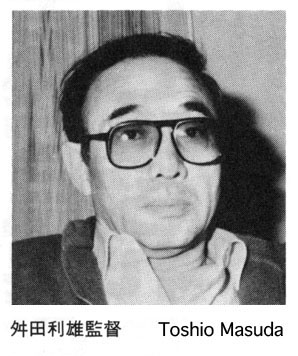
Oka: For me, Farewell to Yamato is the best of the Yamato movies. I think of it as “something that is purely shaped.” The first thirty minutes in particular, up to Yamato’s launch, are flawless with nothing wasted. From that I feel the sharpness of Toshio Masuda from those days. Come to think of it, I saw a lot of Toshio Masuda movies between work…
Habara: Which ones? Tora Tora Tora?
Oka: Yes, Tora Tora Tora and The Zero Fighter. The climax of that became the basis for Farewell to Yamato. In the end, the Yamato movies have the dark color of Masuda. I reconfirmed it.
Interviewer: In terms of the scripts, are there some parts where you think “I did it well here” and others where “I had a hard time, but please take a look”?
Oka: Episode 10 in Chapter 3.
Habara: The space fireflies episode?
Oka: That’s right. Based on an episode of Yamato 2. I was surprised when Mr. Fukui said, “I’m doing the fireflies.” The mood between the Space Cavalry and Yamato’s crew becomes touch-and-go in the second half. There were big changes in the storyboard stage.
Habara: Yes. Kodai and Hajime Saito of the Space Cavalry.
Oka: That was great. I thought, “That fine, that’s the right interpretation!”
Habara: Whether it’s good and whatever happens there (laughs), I hope you’ll see for yourself in a theater.
Oka: Mr. Fukui wrote “This is a part we can’t avoid here” in the composition memo, and I wrote a lively response to it. I was surprised that it was being directed into a completely different interpretation. Things came up that I couldn’t imagine. I really like that scene.
Habara: By the way, the script for Episode 10 comes with the special-edition Blu-ray. Mr. Fukui made that choice.
Oka: Ah! Is that so? (Laughs) I didn’t expect Episode 10.
Habara: I thought it would be Episode 9, but he chose Episode 10. (Laughs)
Oka: Episode 10 has that “Yamato scent,” doesn’t it?
Habara: That’s right, it has a Yamato 2 feeling.
Interviewer: So we can confirm how it was changed. Thank you very much for your time today.
